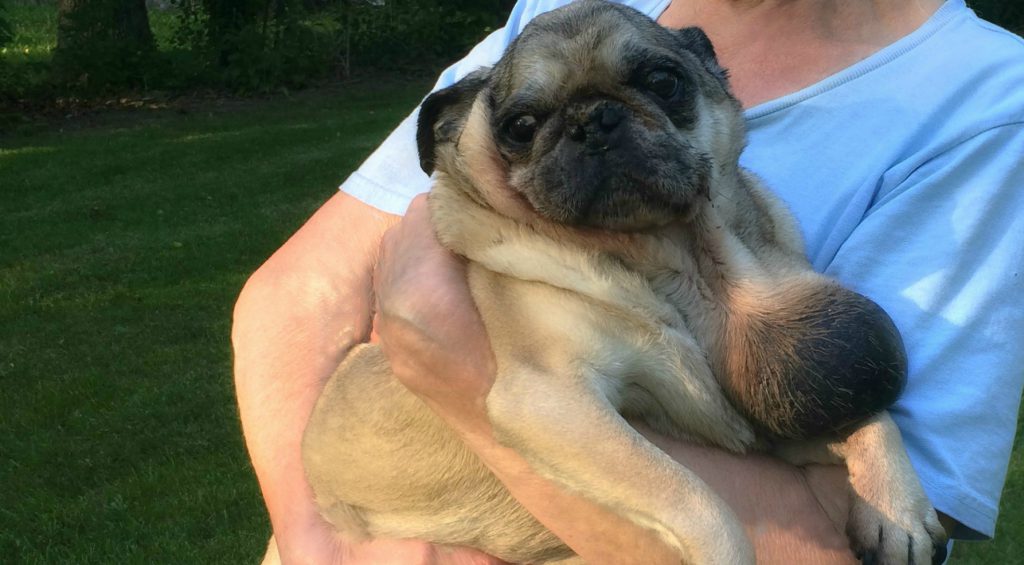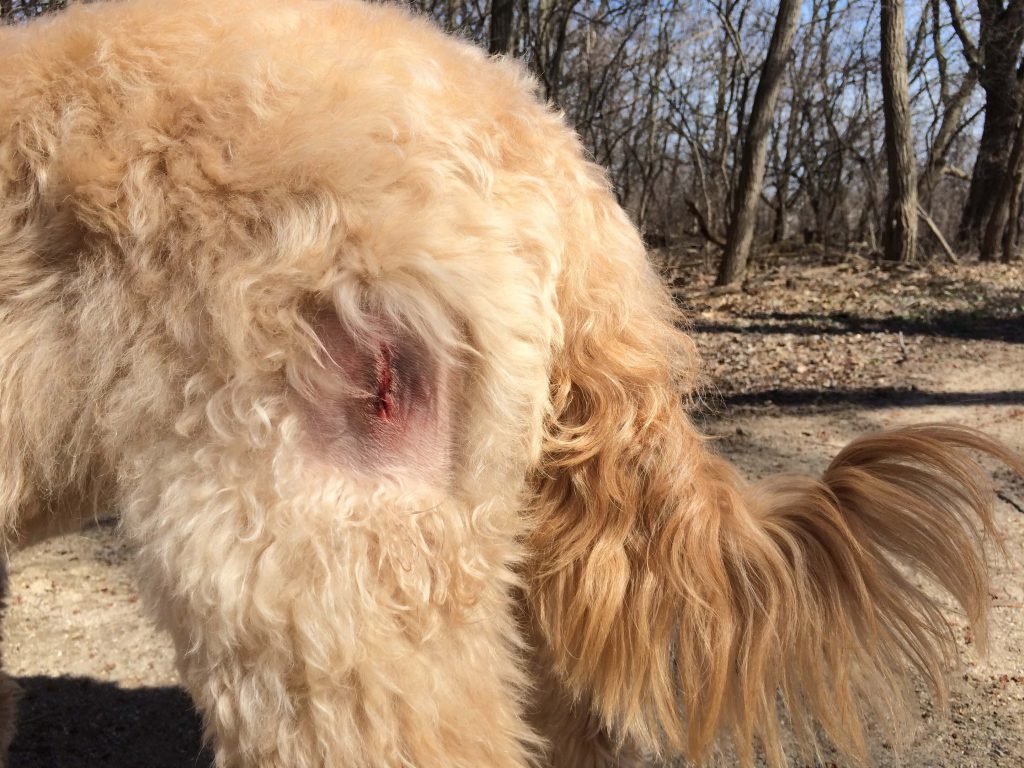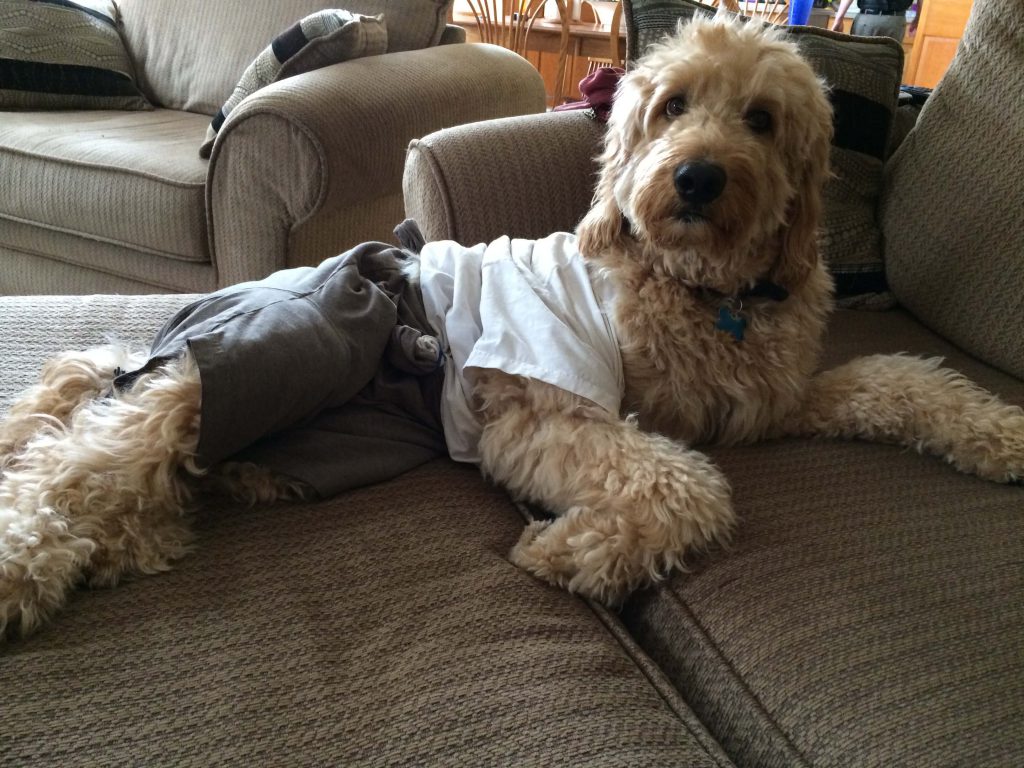Sadly, the first thing that crosses a person’s mind when discovering their dog has a lump, is cancer. However, it is encouraging to know, the vast majority of lumps are benign. Nevertheless, since there are various types of lumps and bumps, and various causes and concerns, any time a lump is discovered it should be checked out by a veterinarian.
My Dog Has a Lump – Lipoma in Dogs
Lipomas are one of the types of lumps that commonly develop in dogs. These lumps are fat-filled, benign, masses that feel firm and round under the skin. They move around freely and do not adhere to the tissue beneath them. You may also have heard them referred to as fatty tumors.
They start out small, but many grow in size and can get to be quite large. My parent’s Pug developed lipoma on her chest, and as you can see in the below photo, it grew to an enormous size.

Since she was elderly, and Pugs (or any of the “pushed in” faced breeds) are at higher risk when putting under anesthesia, it was recommended by the vet that the lipoma not be removed. As large as it was it never seemed to bother her, in fact oftentimes she seemed to use it as a little pillow when she laid down, lol. 🙂
Most dogs that get one lipoma are bound to get more. Fortunately, they are for the most part painless, and harmless, and most dogs won’t even know they are there. The exception would be if the lipoma grew to a large size in an area where it would impede movement such as in the inside of the upper hind leg or foreleg (armpit area).
Last year, I had the unpleasant scare of my own dog developing a lump. My dog is a Goldendoodle, and if you are familiar with that type of dog you know that means lots, and lots, of fluffy hair where lumps and bumps can easily be masked. But, we have been using the same groomer for years now, and knowing our dog as she does, she was able to identify a lump that she knew did not exist before.
We immediately made an appointment with our veterinarian and a fine needle aspirate (simple test done right there in the office) was performed to confirm it was indeed lipoma. Whew! It was a relief to know it was not cancerous.
She then measured the lump and over the next couple of months we went in for checks to see if it was growing in size. It was. Since our dog was healthy and fairly young, our vet gave us the choice of whether or not we wanted to have it removed. With dreaded visions of the lipoma turning into the size of my parent’s Pug’s lipoma, we made the decision to go ahead with removing it.
This is how it looked after surgery…

During recovery we dressed him in jammies (2 t-shirts tied together) to keep him from biting at his stitches. It gave him relief from the e-collar!…

Everything healed up very nicely, and you would never guess there was ever anything there at all.
Fast forward one year later and our dog developed two more lipomas, ugh. We were warned that this was a high probability. He now has one fatty tumor on the side of his rib cage which is very tiny. The other is on the inside of the upper thigh of his hind leg and is only a slight bit smaller than a golf ball at this point. Should it continue to grow, this is one of those areas where it could start to cause some issues with pressing on nerves and messing with his mobility.
Being near to some pretty important internal organs, our veterinarian has explained that removing it is something they prefer not to do unless absolutely necessary. For now, the recommendation is to keep an eye on its size by measuring it periodically, and then we’ll see from there whether it can remain, or whether it will need to be surgically removed.
Unless it is necessary, vets typically don’t recommend removing lipomas, especially if it is simply for cosmetic purposes. Although the procedure for removal is fairly low risk, as with any type of surgical procedure there is always some risk, which just isn’t worth it for a lipoma that is harmless.
However, our vet suggested that if we did need, or want, to remove one or both of the lipomas that we attempt to wait until our dog needs to be put under anesthesia for some other purpose, such as teeth cleaning. In other words, go for hitting two birds with one stone, and not take any risks solely for the purpose of a cosmetic lipoma removal.
Is There a Natural Remedy for Lipoma in Dogs?
I can’t promote, or say for certain at this point that there is a known natural remedy that works. But, I can tell you what we are trying for our dog, and also confirm that although our dog’s lipomas haven’t gone away, they haven’t gotten any bigger either. Is it due to the natural remedies we are trying? At this point, it is too early to tell, so I am not sure. But, in the case that it is, I do plan to continue with it.
the natural remedies our dog is taking have been recommended to us by a pet herbalist. He insists we should be able to get rid of our dog’s lipomas, so we’ll see! Although I’m by no means an expert as far herbal remedies go, I’ve always been under the belief that there are more options than just the medicinal ones. Our dog’s lipomas aren’t a matter of life or death here, and we certainly have nothing to lose, and all to gain so we are all in!
He recommended we start our dog out taking 3 things:
- Ojibwa Tea
Ojibwa tea is said to date back to the Ojibwa tribes of Native Americans in the United States and Canada and was used to help cure cancer. This is a liquid form that we serve over our dog’s food, 1 tbsp in the morning, and 1 tbsp in the evening.
- Artemisinin
This is described as a purified extract of sweet wormwood and comes in a capsule
- Hoxsey-Like
This is his own formula and contains the following herbs: Oregon grape, burdock root, red clover, pokeroot, dandelion root yellow dock root, licorice root, red root, prickly ask bark & slippery elm bark. This is a liquid form that we serve over our dog’s food, 1 tsp in the morning, and 1 tsp in the evening.
(I do NOT recommend any of the above for anyone’s dog prior to speaking with a veterinarian, animal herbalist, or holistic vet. What may be okay for one dog may not be okay for the next.)
This is what we are trying, for now, we’ll see how it goes!


